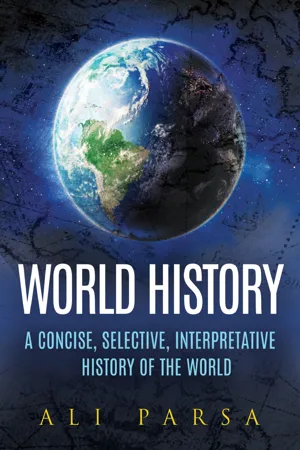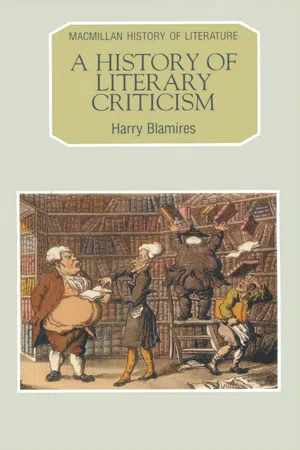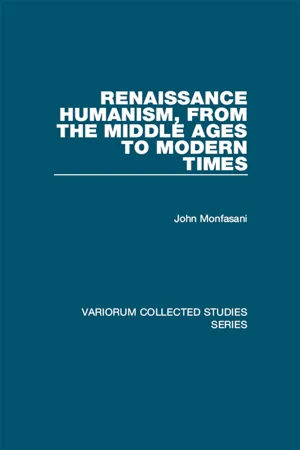Literature
Renaissance
The Renaissance was a cultural movement in Europe during the 14th to 17th centuries, characterized by a revival of interest in classical learning, art, and literature. It marked a shift from the medieval to the modern world, with a focus on humanism, individualism, and the exploration of new ideas. Renaissance literature often reflected these themes through works that celebrated human potential and the beauty of the natural world.
Written by Perlego with AI-assistance
Related key terms
6 Key excerpts on "Renaissance"
- eBook - ePub
- Helen Hackett(Author)
- 2012(Publication Date)
- I.B. Tauris(Publisher)
c. 1585–1603) and the Jacobean period (1603–25) since these produced most of the Renaissance plays that are well known today. Its aims are threefold: to convey the variety and richness of English Renaissance drama; to explore why and how this period produced this creative explosion; and to suggest why these plays continue to have such hold upon readers and audiences in the modern world.WHAT WAS THE Renaissance?At the outset it is worth pausing to consider what we mean by the term ‘Renaissance’. Literally it means ‘rebirth’, and the Oxford English Dictionary defines it as ‘the revival of the arts and high culture under the influence of classical models, which began in Italy in the fourteenth century and spread throughout most of Europe by the end of the sixteenth.’6 It took a little time for these developments to reach England, and therefore the English Renaissance is usually regarded as having taken place in the sixteenth and seventeenth centuries. In English drama, the period of greatest activity and artistic achievement was from the late 1580s to the 1620s, covering the last part of the Elizabethan period (Elizabeth I reigned from 1558 to 1603) and the Jacobean period (the reign of James I, 1603–25).Fifteenth-century Italy saw an artistic and intellectual flowering which many of its participants regarded self-consciously as a movement of renewal and of the rediscovery of the classical arts and scholarship that had fallen into decay in the middle ages. Classicism became associated with purity, naturalism, and clarity, as opposed to the supposed gothic barbarity of intervening centuries. This attitude was crystallized in the term rinascita , or rebirth, first used by the Italian artist and critic Giorgio Vasari (1511–74) in his book The Lives of the Artists (1550) to describe how Italian painters and sculptors of the fourteenth to sixteenth centuries had revived classical style and techniques. The general use of the term ‘Renaissance’ in cultural history began later, with The Civilization of the Renaissance in Italy (1860) by the Swiss author Jacob Burckhardt (1818–97). For Burckhardt the cultural advances of Italy in the fourteenth to sixteenth centuries were dependent upon the existence of competing independent city states ruled by despotic dynasties, who deployed artistic patronage as a means of celebrating and promoting their power. In this culture, despots and artists alike personified the triumph of the self-interested human will: ‘Despotism . . . fostered in the highest degree the individuality not only of the tyrant or condottiere himself, but also the men whom he protected or used as his tools.’ Burckhardt takes as an example Leon Battista Alberti (1404–72), an author, artist, and architect: ‘an iron will pervaded and sustained his whole personality; like all the great men of the Renaissance, he said, “Men can do all things if they will.”’ In his mastery of a wide and diverse range of intellectual interests Alberti also exemplified Burckhardt’s idea of the Renaissance man, ‘the “all-sided man” – l’uomo universale ’.7 - eBook - ePub
- C. Scott Dixon, Beat Kümin(Authors)
- 2019(Publication Date)
- Routledge(Publisher)
4 Renaissance Edward Muir The interpretive challenge for Renaissance studies began in the nineteenth century, not the fourteenth, fifteenth, and sixteenth, the age of the Renaissance. Unlike the Enlightenment, no one living during the Renaissance knew about it. An ardent anti-clerical republican, Jules Michelet (1798–1874), popularised the term Renaissance (rebirth), and hence the French word still prevails in the English-speaking world in place of the Italian Rinascimento. A whiff of Michelet’s secular prejudices still lingers over the idea of the Renaissance. During the same period the Swiss Protestant, Jacob Burckhardt (1818–1897) wrote The Civilization of the Renaissance in Italy, which introduced art and cultural history as a pre-eminent means for understanding the period. Burckhardt’s innovative approach of Kulturgeschichte has been especially attractive because of his evocative portrait of how political illegitimacy produced artistic and intellectual vitality, epitomised by his famous phrase, ‘the state as a work of art’ (1958, 21). The Prussian Georg Voigt (1827–1891) added to the interpretive mix the term ‘humanism’, designating a movement that began with Francesco Petrarca [Petrarch] (1304–1374), who popularised among intellectuals methods of critical philology rooted in classical Antiquity. From this influential trio, none Italian, came a remarkably tenacious paradigm that defined the Renaissance as a period that began in the fourteenth century in Italy in reaction to the alleged clerical domination of the Middle Ages and that was characterised by secularism, artistic and cultural creativity, and humanism (defined as the critical, historical methods of philology) - eBook - ePub
World History
A Concise, Selective, Interpretive History of the World
- Ali Parsa(Author)
- 0(Publication Date)
- Sentia Publishing(Publisher)
Now, let us get started with the discussion of the European Renaissance. At the outset, I must clarify one of the most common misunderstandings of what Renaissance means. Most people associate the term Renaissance mainly with fantastic art, paintings, and architecture produced by great masters, such as Michelangelo, Rafael, and da Vinci. But in reality, the Renaissance was a much broader intellectual-humanistic transformation that changed the whole worldview of Western Europeans and subsequently the whole world. Art and architecture, as beautiful and publicly enjoyed and appreciated as they are, are only the products of a much bigger change.Renaissance means rebirth. Something must die in order to be born again. That one thing, according to the people who invented the term in the fifteenth century, was the glorious classic era of the Greco-Roman times, before the fall of Rome in the fifth century, when human beings were valued and creativity was rewarded. Out of the ashes of the Late Middle Ages, which were dominated by dogmatism and otherworldliness, a new focus on human beings began.The Renaissance HumanismA good way of understanding the essence of the Renaissance is to break it down into its three major aspects. The first aspect of the Renaissance, as it is most easily understood, is the yearning for the classics. It is not surprising that the Italians, who considered themselves to be descendants of and successors to the great Roman civilization, would be the pioneers of this movement. The father of Renaissance humanism is Francesco Petrarch. Although Italians had become wealthy through international maritime trade, they were politically divided. Feudalism, as had been developed in the rest of Europe, was not as strong in Italy. Instead, an urban economy with a growing middle class was taking shape. Petrarch, who was an erudite man, well versed in classical Latin and possessing a great knowledge of history, should be credited as the first person who tried to awaken the Italians to their glorious past in which human beings were valued and individuals were respected. - eBook - ePub
- Harry Blamires(Author)
- 1991(Publication Date)
- Bloomsbury Academic(Publisher)
3 The RenaissanceThe term ‘Renaissance’ is sometimes so vaguely used that it tends to represent a period of history rather than a historical development. In its strictest sense, at least for the literary world, the ‘Renaissance’ is the rediscovery of the ancient classics of Greece and Rome which scholars edited, translated, and wrote commentaries on. With the capture of Constantinople by the Turks in 1453 the drift of Greek scholars to Italy was accelerated. Increasingly manuscripts were transferred from Byzantium to the west and copied. It must be recalled that the Emperor Constantine (288–337) had transferred his capital to Byzantium in 328 and renamed the city ‘Constantinople’. After the death of the emperor Theodosius the Great (c.346–395) the Roman Empire was split into two halves, one of Theodosius’s sons ruling from Rome, the other from Constantinople. As Rome declined and ceased finally in 476 to be the seat of an emperor, Constantinople remained for nearly a thousand years an imperial centre capable of defending its culture against invaders.The increasing influx of scholarship from Byzantium into western Europe came at a time when new impulses were already at work and, it may be argued, merely quickened and intensified an already inevitable reaction against the theological, philosophical, and artistic culture of the Middle Ages. The revival of Greek and Latin forms, first in Italy, and then elsewhere in west Europe, was not just a literary development, but affected architecture too. Economically Italy was especially ripe for change in that the fabric of feudalism had been weakened by the growing wealth and importance of trading cities such as Florence and Venice, and the growing power of the now urbanised middle class. This was, of course, to be the pattern of change in other European countries too. Currents of new vitality gave an impulse to cultural productivity and development just when a source of fresh inspiration was being tapped in the rediscovery of the classics. - John Monfasani(Author)
- 2016(Publication Date)
- Routledge(Publisher)
38 .I find irrefutable the medievalists’ claims for the Renaissance of the twelfth century. The twelfth-century poets, grammarians, commentators, translators, and other scholars were responsible for an enormously successful recovery of antique language, learning, and literature39 . That recovery took place mainly in northern Europe and continued into the thirteenth century. Nonetheless by the fourteenth century Italians had clearly taken the lead and would eventually produce far more brilliant results than did the earlier medieval humanists.But what is critical to understand is that at this very same time in the thirteenth and especially fourteenth centuries Italians were also absorbing northern scholasticism and developing their own very distinctive university structure. As Kristeller has pointed out, even if one denies that there was a Renaissance, one cannot deny that there was a Renaissance of Italy40 . From a relatively backward cultural position before the fourteenth century, Italy surged to leadership by the late fifteenth century as cultural forms that it had been developing since at least the thirteenth century began to exert decisive influence on the rest of Europe. Indeed, I would go further and contend that the Renaissance was a period of Italian cultural leadership in Europe displacing traditional French cultural leadership41 , and that the end of the Renaissance was the reassertion of French cultural leadership in the seventeenth and eighteenth centuries in a world that increasingly rejected medieval traditions. In his recent book on Tommaso Campanella, John Headley captured a poignant moment in this transition42 . When Campanella, the celebrated anti-Aristotelian author of City of the Sun, escaped from Italy to France in 1634, his enthusiastic French supporters, especially Marin Marsenne and Pierre Gassendi, now came to see him as yesterday’s man. This great representative of what was once daring and new now seemed sadly passé. French intellectuals were moving in another direction. The Enlightenment was superseding the Renaissance. When the French reasserted their traditional cultural leadership in the Enlightenment, they consciously rejected not only the Middle Ages, but also the Italian Renaissance43- eBook - ePub
- William Caferro(Author)
- 2017(Publication Date)
- Routledge(Publisher)
3The virulence of the rejection of the Renaissance was proportional to the enthusiasm of its prior acceptance. But in reality the field was always a contested one. When Jacob Burckhardt (1818–1897) published his seminal Civilization of the Renaissance in Italy in 1860, he took care to call it “ein Versuch” (an attempt/essay), underscoring its speculative nature. Burckhardt’s famous contemporary John Ruskin (1819–1900) expressed dislike for the Renaissance on account of its interest in the classical past – the central feature of the period as he saw it – which substituted pagan values for Christian ones.4 Meanwhile, Walter Pater (1839–1894) accepted the Renaissance as a “complex, many-sided movement,” representing, as in Burckhardt, the “outbreak of human spirit.” But in his Studies in the History of the Renaissance (1873) he added the very anti-Burckhardtian qualification that this spirit could “be traced far into the Middle Ages.”5 Pater’s medieval component anticipated the famous assessment of Charles Homer Haskins, whose The Renaissance of the Twelfth Century (1927) touched off the so-called “revolt of medievalists,” who found – and continue to find – many of the same features in their own era and have accordingly sought a similar priority for their field.6It is, I would argue, this combative past that has propelled the field forward, kept it relevant, resilient, and made it a battleground for new theories, competing interpretations, and scholarly innovation.7 Rather than eliminate the discipline, new scholarship has broadened and enriched it.8 The Renaissance has served as an early locus for investigation of issues relating to gender and application of anthropological and psychoanalytical theory. The cultural anthropology of Clifford Geertz and his notion of “thick description” have been employed to look at Renaissance rituals and the ways people lived – helping historians move away from a static Enlightenment view of human nature to a more contextual one. The field has brought together into conversation, if not always amicably, historian with art historian with literary critic. The Renaissance has been the site for new historicist and postmodern approaches, which have called into question some of its most basic assumptions, including the very utility of historical categories and patterns. In the hands of the literary critic Stephen Greenblatt – drawing from both Geertz and Michel Foucault – Burckhardt’s modern Renaissance “individual” became “a cultural artifact.”9
Learn about this page
Index pages curate the most relevant extracts from our library of academic textbooks. They’ve been created using an in-house natural language model (NLM), each adding context and meaning to key research topics.





